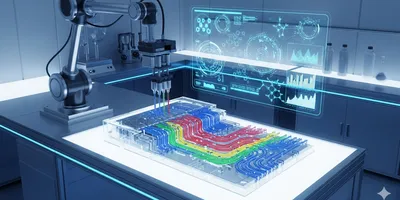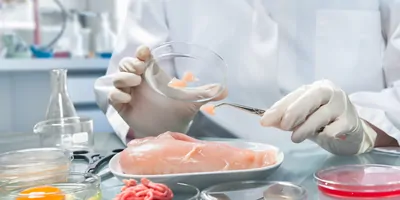The field of analytical chemistry is in the midst of a profound transformation. For decades, the core principles of separation, identification, and quantification have been refined through increasingly powerful and complex instruments. However, a new wave of innovation, driven by advancements in microtechnology, artificial intelligence, and a global commitment to sustainability, is fundamentally reshaping how we approach chemical analysis. For laboratory professionals, staying ahead of these trends is not merely a matter of efficiency; it is a necessity for maintaining relevance and pioneering new scientific discoveries.
This article explores the future of analytical chemistry, delving into the key innovations that are poised to redefine the modern laboratory. From the micro-scale to the molecular level, these advancements promise to deliver unprecedented speed, sensitivity, and insights, while also addressing the critical need for more sustainable and cost-effective practices. We will examine how lab-on-a-chip technology, the power of AI real-time data interpretation, the remarkable precision of single-molecule detection, and the imperative of sustainable analytical chemistry are converging to create a new paradigm for the scientific community.
The Rise of Miniaturization: Lab-on-a-Chip Technology
Miniaturization is a dominant theme in the future of analytical chemistry. The concept of a lab-on-a-chip (LOC), which integrates one or more laboratory functions onto a single chip a few millimeters to a few square centimeters in size, is moving from a niche research topic to a cornerstone of modern diagnostics and analysis. This shift is enabled by microfluidics, the science of manipulating fluids at the micro- and nano-scale. LOC devices can perform complex tasks, such as sample preparation, separation, and detection, using microliter or even nanoliter volumes of fluid.
The principles behind LOC technology are compelling. By moving from bulky, benchtop instruments to small, integrated devices, we achieve several critical advantages. First, sample and reagent consumption are drastically reduced, leading to lower costs and less waste. Second, the small size and short diffusion distances enable exceptionally fast analysis times. A reaction that might take minutes or hours in a traditional lab can be completed in seconds on a chip. Third, the portability of LOC devices unlocks new possibilities for point-of-care diagnostics, on-site environmental monitoring, and in-field analysis, bringing the lab to the sample rather than the other way around.
The applications of lab-on-a-chip are expanding rapidly. In clinical diagnostics, they are being used for rapid infectious disease testing (e.g., influenza, COVID-19), glucose monitoring, and cancer biomarker detection. In environmental science, they facilitate on-site analysis of water quality or the presence of pollutants. The fabrication methods for these chips are also evolving, with new techniques like 3D printing and soft lithography (using materials like polydimethylsiloxane, or PDMS) making prototyping and customization more accessible. This technological convergence is fueling a new era of analytical power in a compact format.
Key Benefits of Lab-on-a-Chip:
- Reduced Sample and Reagent Volume: Minimizes costs and waste.
- Faster Analysis Times: Short diffusion distances lead to rapid results.
- Enhanced Portability: Enables point-of-care and on-site analysis.
- High-Throughput Potential: Allows for massive parallelization of assays on a single chip.
- Improved Safety: Smaller volumes of hazardous materials reduce risk.
Harnessing Data Power: AI Real-Time Data Interpretation
Analytical chemistry instruments have become masters of data generation, producing vast datasets from spectroscopy, chromatography, and mass spectrometry. The challenge has shifted from acquiring data to efficiently and accurately interpreting it. This is where artificial intelligence (AI) is proving to be a game-changer, fundamentally changing the future of analytical chemistry. The most impactful application of AI is in AI real-time data interpretation. Instead of relying solely on human expertise to manually analyze complex chromatograms or spectral data, machine learning algorithms can now process this information instantly, identifying patterns and anomalies that might be invisible to the human eye.
Lab Quality Management Certificate
The Lab Quality Management certificate is more than training—it’s a professional advantage.
Gain critical skills and IACET-approved CEUs that make a measurable difference.
The core principle involves training AI models on large historical datasets. The model learns to recognize specific patterns associated with different compounds, impurities, or instrument malfunctions. This enables a new level of automation and insight. For example, in a high-performance liquid chromatography (HPLC) run, an AI model can automatically perform peak integration and deconvolution, even for highly complex, co-eluting peaks. This not only accelerates the data review process but also improves the accuracy of quantification. Similarly, in mass spectrometry, AI algorithms can instantly match unknown spectra to vast compound libraries, providing a level of certainty and speed that was previously unattainable.
Beyond interpretation, AI is also driving other critical lab functions:

AI can have several uses in the lab, allowing professionals to spend more time with complex problems.
GEMINI (2025)
- Method Development: AI can predict optimal chromatographic conditions, saving a significant amount of time and solvent that would otherwise be spent on trial-and-error.
- Predictive Maintenance: By monitoring real-time instrument data, AI models can detect subtle changes in performance that precede a malfunction. This enables labs to perform proactive maintenance, preventing costly and disruptive instrument downtime.
- Automated Quality Control: AI can continuously monitor analytical data streams, automatically flagging out-of-specification results or potential issues with a batch, ensuring compliance and data integrity without constant human oversight.
The shift to an AI-driven lab environment is not about replacing the analytical chemist. It is about augmenting their capabilities, freeing them from tedious, repetitive tasks so they can focus on more complex problem-solving, method validation, and innovative research.
Pushing the Limits: The Power of Single-Molecule Detection
For most of its history, analytical chemistry has been an "ensemble" science, measuring the average behavior of a large population of molecules. While incredibly effective, this approach can obscure subtle, but critical, heterogeneity within a sample. The latest wave of innovation is pushing the analytical frontier to the ultimate limit: the single-molecule detection level. This is a profound shift that is transforming everything from disease diagnostics to fundamental materials science.
The principle of single-molecule detection involves using highly sensitive techniques to observe and characterize individual molecules. This is a significant departure from traditional methods that measure the bulk signal from billions or trillions of molecules. By studying individual molecules, scientists can uncover a wealth of information that is averaged out in an ensemble measurement, such as conformational changes, stochastic reaction pathways, and subtle variations between molecules in a seemingly identical population.
This has become feasible through the development of highly advanced technologies:
- Single-Molecule Fluorescence Microscopy: Techniques like Total Internal Reflection Fluorescence (TIRF) microscopy can excite and detect the fluorescence of individual molecules on a surface, allowing for real-time observation of biological processes.
- Nanopore Sensing: This method involves threading a molecule, such as DNA or a protein, through a tiny nanopore. As the molecule passes through, it disrupts a tiny electrical current, and the unique signature of this disruption can be used to identify and characterize the molecule with incredible precision. Recent breakthroughs have enabled the use of nanopores to detect and characterize structural variations on proteins at the single-molecule level, which could revolutionize diagnostics for neurodegenerative diseases and cancer.
- Surface-Enhanced Raman Spectroscopy (SERS): SERS utilizes plasmonic nanomaterials to drastically amplify the Raman signal of a single molecule, enabling its identification and structural analysis.
The impact of single-molecule detection is immense. In personalized medicine, it enables the early detection of disease biomarkers at extremely low concentrations, long before symptoms appear. In drug discovery, it provides a new way to screen for drug-target interactions with unprecedented fidelity. Ultimately, this innovation provides a new lens through which to view the chemical world, revealing its intricacies with a level of detail that was once unimaginable.
Greening the Lab: The Imperative of Sustainable Analytical Chemistry
The push for sustainability is not just a societal trend; it is a critical and growing discipline within analytical chemistry. For lab professionals, the environmental impact of their work is a real and pressing concern. The use of large volumes of toxic and flammable organic solvents, the generation of significant waste, and high energy consumption are all areas that require focused innovation. This is the essence of sustainable analytical chemistry, a philosophy and practice that aims to minimize the environmental footprint of analytical processes without compromising performance.
The principles of Green Analytical Chemistry (GAC) are based on the core tenets of Green Chemistry, adapted for the analytical workflow. This includes reducing the use of hazardous substances, minimizing waste, and designing more energy-efficient methods. The future of analytical chemistry is intrinsically linked to these efforts.
Practical Steps for a More Sustainable Lab:
Solvent Reduction and Replacement:
- Switch to greener solvents like water, supercritical carbon dioxide (CO2), or ionic liquids.
- Miniaturize methods (e.g., using micro-extraction techniques) to reduce solvent consumption.
- Consider solvent-free methods like solid-phase microextraction (SPME).
Miniaturization and Automation: The move toward lab-on-a-chip and microfluidics directly contributes to sustainability by using smaller sample volumes and less reagent. Automated systems also help by reducing waste from manual errors.
Energy Efficiency:
- Opt for instruments with lower power consumption.
- Optimize methods to reduce run times, thereby decreasing the energy used per analysis.
- Utilize techniques like capillary electrophoresis, which require less energy and solvent than many traditional chromatographic methods.
Waste Prevention and Management:
- Implement in-situ analysis whenever possible to avoid sample transport and additional reagent use.
- Prioritize reusable materials and consumables.
- Improve solvent and waste segregation to facilitate proper disposal and recycling.
Embracing sustainable analytical chemistry is not just an ethical choice; it can also be a financially savvy one. Reducing solvent and reagent use directly lowers operating costs, and more efficient methods can lead to increased throughput and productivity.
Navigating the Future of Analytical Chemistry
The future of analytical chemistry is not defined by a single breakthrough but by the convergence of multiple innovative trends. Miniaturization through lab-on-a-chip technology is making analysis faster and more portable. The integration of AI is transforming complex data into actionable insights in real time, and the pursuit of single-molecule detection is revealing a new level of chemical understanding. Simultaneously, the imperative of sustainable analytical chemistry is ensuring that this progress is responsible and environmentally conscious.
For lab professionals, this new era presents both challenges and opportunities. The need for new skills—such as an understanding of data science, microfluidics, and advanced instrumentation—is paramount. However, by embracing these innovations, we can move beyond the limitations of traditional methods and unlock unprecedented capabilities. The laboratory of tomorrow will be smarter, more efficient, and more sustainable. By actively engaging with these trends, we can shape the next generation of scientific discovery and meet the complex analytical challenges of our world.














